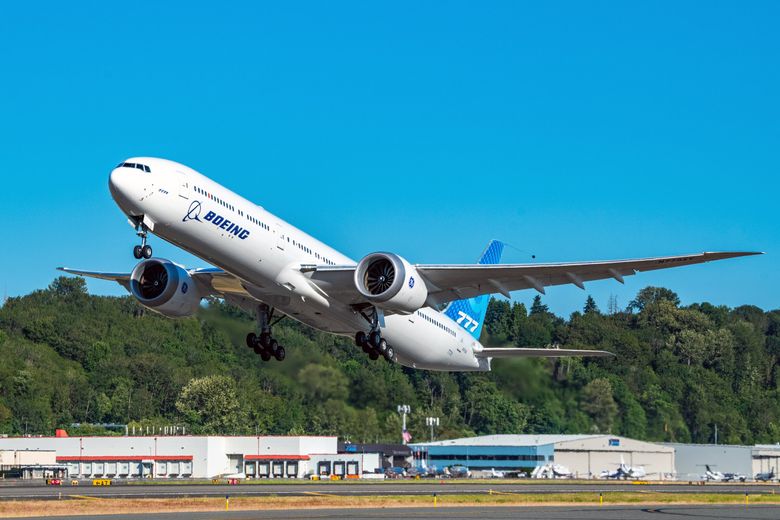Boeing & Aerospace
Business
Nation
Boeing 777X finally gets FAA green light for certification flights
July 13, 2024 at 12:24 pm Updated July 13, 2024 at 1:03 pm

The 777-9X takes off for its first certification flight test Friday from Boeing Field near Seattle. (Marian Lockhart / Boeing)

By
Dominic Gates
Seattle Times aerospace reporter
In an important milestone in the development of Boeing’s new 777X commercial jet, the Federal Aviation Administration has granted authority to begin a sequence of test flights needed to win approval for the 777X to enter passenger service.
For these tests, FAA pilots and engineers will be on board the new large airplane alongside Boeing’s pilots and flight test team.
They will observe firsthand how the jet performs in a series of rigorous maneuvers far beyond what a commercial jet normally encounters.
Boeing test pilots conducted the first certification flight test Friday evening with FAA personnel aboard the aircraft. It took off from Boeing Field just after 6 p.m. and landed there again almost two hours later after flying along the Washington and Oregon coast.
The news is a major boost for Boeing. It should unlock new orders for the aircraft, sales of which have been stalled by yearslong delays in its development and lack of progress toward getting it certified to fly passengers.
The news comes just a week before the Farnborough Air Show opens near London, where Reuters reported Boeing is expected to announce at least one new 777X order, for more than 20 of the jets from Korean Air.
Over the next year to 18 months, Boeing must put the plane through a series of demanding flight tests on four separate test aircraft to demonstrate to the FAA that the 777X can be certified as satisfying all safety regulations.
Boeing has been flying the plane for more than four years and the FAA has insisted until now that more analysis was needed. Now finally, it’s ready to fly for credit.
The 777X is an upgraded and larger version of the all-metal 777 twinjet that debuted in the mid-1990s.
It features new engines and new carbon composite wings, so long that Boeing had to design 11-foot-long wingtips that fold up so the plane can fit at standard airport gates.
The first version, now being tested, is the 777-9X, which will carry 426 passengers in two-class seating on long-haul international flights.
A slightly smaller model, the 777-8X, will follow later in both freighter and passenger variants.
Boeing has won 481 orders for the aircraft to date, with Gulf carrier Emirates by far the largest customer, with just over 200 on order.
With Airbus having discontinued its A380 superjumbo jet for lack of sales, the 777X is now the largest new commercial jet available to airlines.
In addition to the four test airplanes, Boeing has already built and stored 22 of the 777X jets, many of those parked nose-to-tail on a runway at Paine Field with large blocks hanging from their wings in place of engines.
Another six are in various stages of assembly in Everett, according to a reliable online list of production airplanes.
All of those jets built before certification is achieved will have to be reworked with any changes developed during the flight test program before they can be delivered to airlines.
Long delays in developmentIn the past, new Boeing jets were generally certified and cleared to enter service within 18 months of first flight. The original 777 was certified almost exactly a year after it first flew in 1994.
The 777X was launched at the Dubai Air Show in 2013, first flew in January 2020 and now it looks like it could get certified in the second half of 2025, an unprecedented length of time to develop a derivative of an existing airplane.
By this point, Boeing said it has already put the 777-9X test fleet through “more than 1,200 flights and 3,500 flight hours across a wide range of regions and climate conditions.”
Now it must repeat many of those tests for the FAA to observe, including in-flight stalls, deliberate tail strikes and aborted takeoffs at full weight and speed.
“The certification flight testing will continue validating the airplane’s safety, reliability and performance,” Boeing said via email. “We appreciate our regulator’s rigorous oversight.”
Indeed, the FAA has never been more rigorous.
The 777X’s development was caught up in the tougher regulatory scrutiny of Boeing’s products that followed two fatal crashes of its 737 MAX jets in 2018 and 2019 that combined killed 346 people.
The FAA and European regulators demanded extensive testing and redesign of several 777X components, including a critical avionics system that governs the movement of flight control surfaces on the jet’s wings and tail.
In a scathing letter three years ago, 17 months after the jet’s first flight, the FAA told Boeing it wasn’t nearly ready. Boeing’s safety assessments lacked data, software fixes were missing and Boeing was introducing new design changes.
The FAA wrote then that its “concern is due to the addition of late changes; Boeing needs to ensure the changes do not introduce new, inadvertent failures.”
Boeing was ordered to “close these gaps” before even requesting that the FAA allow certification flight testing to begin.
Three years later, the FAA is now satisfied and Boeing can finally move forward.
In what has been a bleak year for Boeing, it’s a much-needed lift.
Bloomberg News contributed to this report.
Dominic Gates: 206-464-2963 or dgates@seattletimes.com; Dominic Gates is a Pulitzer Prize-winning aerospace journalist for The Seattle Times.
seattletimes.com |






